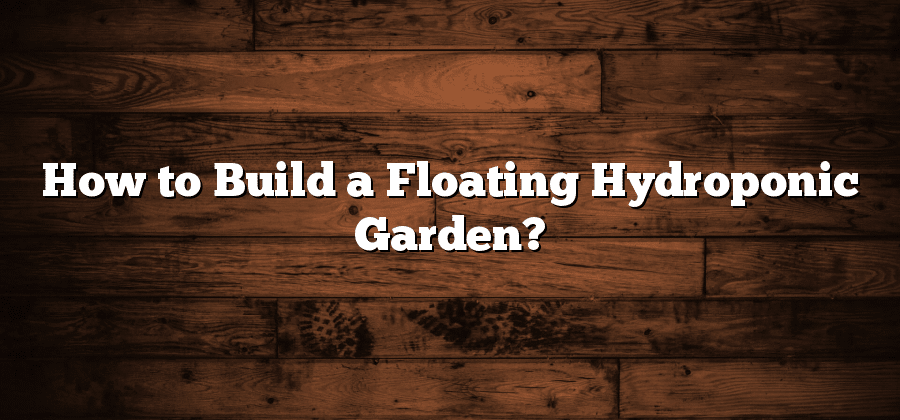Understanding the Concept of Floating Hydroponic Gardens
Floating hydroponic gardens are an innovative and sustainable method of gardening that is gaining popularity among both commercial growers and home gardeners. Unlike traditional soil-based gardening, this method involves suspending plants in a nutrient-rich solution without the use of soil. Instead, the plants’ roots are directly exposed to the water, which contains a carefully balanced mixture of essential nutrients. This allows the plants to absorb nutrients more efficiently and grow at an accelerated rate.
The concept of floating hydroponic gardens is rooted in the principle of harnessing the power of water to support plant growth. By providing a controlled environment for the plants, gardeners can optimize conditions such as temperature, pH levels, and nutrient availability. This method also offers the advantage of conserving water, as the system recirculates and reuses the nutrient solution. Additionally, floating hydroponic gardens can be set up in a variety of containers, making them suitable for various spaces, including urban rooftops and small balconies. With the right knowledge and techniques, anyone can successfully establish and maintain a flourishing floating hydroponic garden.
Selecting the Ideal Container for Your Floating Hydroponic Garden
When selecting the ideal container for your floating hydroponic garden, there are a few important factors to consider. First and foremost, you’ll need a container that is large enough to accommodate the size of your plants and allow for proper root growth. While you may be tempted to opt for a smaller container to save space, it’s important to remember that cramped roots can hinder plant growth and ultimately lead to an unsuccessful garden.
In addition to size, it’s also essential to choose a container that is durable and water-resistant. Since your hydroponic garden will be floating on water, the container needs to be able to withstand the harsh conditions of being constantly exposed to moisture. Look for containers made from materials such as plastic or fiberglass, as these are lightweight, durable, and resistant to rust or corrosion. Additionally, consider containers with built-in drainage holes to ensure proper water circulation and prevent root rot. By carefully selecting the right container, you are setting the foundation for a thriving floating hydroponic garden.
Choosing the Right Plants for a Floating Hydroponic Garden
When it comes to choosing the right plants for a floating hydroponic garden, it is important to consider a few key factors. First and foremost, you should think about the size and weight of the plants. Since they will be floating on water, it is crucial to select plants that are not too large or heavy, as this can impact the stability of the floating platform. Opt for smaller plants that have shorter roots and are more compact in size.
In addition to size and weight, it is also essential to choose plants that thrive in a hydroponic environment. These plants are typically known for their ability to absorb nutrients directly from the water, rather than through traditional soil-based systems. Some popular choices for floating hydroponic gardens include lettuce, spinach, herbs like basil and mint, and even strawberries. It is important to research each plant’s specific requirements to ensure that you provide the ideal growing conditions.
Preparing the Floating Platform for Your Hydroponic Garden
To prepare the floating platform for your hydroponic garden, there are a few important steps to follow. First, ensure that the platform is sturdy and stable enough to support the weight of the plants, containers, and water. It’s crucial to select a platform made of durable materials such as treated wood or plastic, as they are less prone to rotting or water damage.
Next, consider the size and shape of the platform. The dimensions will depend on the available space and the number of plants you intend to grow. It’s important to leave enough room for each plant to have adequate growing space, avoiding overcrowding which can hinder their growth and development. Additionally, consider the positioning of the platform in relation to sunlight. Make sure it is placed in an area that receives sufficient sunlight throughout the day to optimize the plants’ photosynthesis process.
When preparing the floating platform for your hydroponic garden, it is also essential to create a barrier to prevent the soil, containers, or plants from falling into the water. This can be accomplished by installing a mesh or wire fence around the edges of the platform. The barrier will not only keep everything in place but also protect the water from potential contamination. Additionally, consider adding a slope to the platform to promote drainage and prevent excess water accumulation, which can lead to root rot or other plant diseases.
Setting Up the Water System for Your Floating Hydroponic Garden
One of the crucial aspects of setting up a successful floating hydroponic garden is establishing an efficient water system. This system plays a vital role in providing the necessary nutrients and hydration to the plants. When designing your water system, it is important to consider factors such as the size of your garden, the number of plants, and the available space.
To begin, you will need to select an appropriate water reservoir. This reservoir will hold the nutrient solution that will be circulated through the garden. It is recommended to choose a container that is large enough to accommodate the needs of your plants, while also being easily accessible for maintenance. Additionally, ensure that the container is made of a durable material that can withstand constant water exposure. Once you have chosen the reservoir, you will need to set up a pump and tubing system to circulate the nutrient solution. The pump should be powerful enough to provide adequate water flow to all the plants in your garden.






